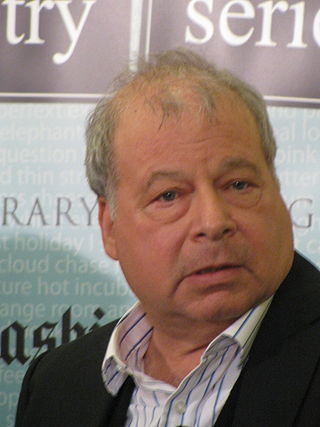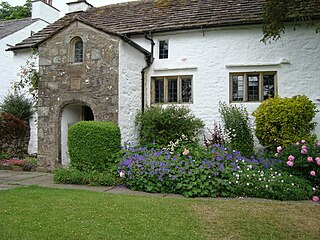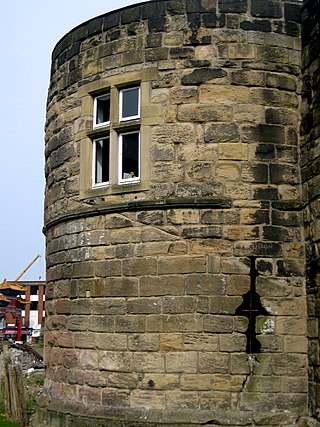Poetry is a form of literary art that uses aesthetic and often rhythmic qualities of language to evoke meanings in addition to, or in place of, literal or surface-level meanings. Any particular instance of poetry is called a poem and is written by a poet.
Poetry analysis is the process of investigating the form of a poem, content, structural semiotics, and history in an informed way, with the aim of heightening one's own and others' understanding and appreciation of the work.
Rhyme royal is a rhyming stanza form that was introduced to English poetry by Geoffrey Chaucer. The form enjoyed significant success in the fifteenth century and into the sixteenth century. It has had a more subdued but continuing influence on English verse in more recent centuries.

Modernist poetry in English started in the early years of the 20th century with the appearance of the Imagists. Like other modernists, Imagist poets wrote in reaction to the perceived excesses of Victorian poetry, and its emphasis on traditional formalism and ornate diction.
The Objectivist poets were a loose-knit group of second-generation Modernists who emerged in the 1930s. They were mainly American and were influenced by, among others, Ezra Pound and William Carlos Williams. The basic tenets of objectivist poetics as defined by Louis Zukofsky were to treat the poem as an object, and to emphasize sincerity, intelligence, and the poet's ability to look clearly at the world. While the name of the group is similar to Ayn Rand's school of philosophy, the two movements are not affiliated.

Basil Cheesman Bunting was a British modernist poet whose reputation was established with the publication of Briggflatts in 1966, generally regarded as one of the major achievements of the modernist tradition in English. He had a lifelong interest in music that led him to emphasise the sonic qualities of poetry, particularly the importance of reading poetry aloud: he was an accomplished reader of his own work.

Roy Fisher was an English poet and jazz pianist. His poetry shows an openness to both European and American modernist influences, whilst remaining grounded in the experience of living in the English Midlands. Fisher has experimented with a wide range of styles throughout his long career, largely working outside of the mainstream of post-war British poetry. He has been admired by poets and critics as diverse as Donald Davie, Eric Mottram, Marjorie Perloff, Sean O’Brien, Peter Robinson, Mario Petrucci and Gael Turnbull.
Tom Pickard is a poet, and documentary film maker who was an important initiator of the movement known as the British Poetry Revival.
"This Be The Verse" is a lyric poem in three stanzas with an alternating rhyme scheme, by the English poet Philip Larkin (1922–1985). It was written around April 1971, was first published in the August 1971 issue of New Humanist, and appeared in the 1974 collection High Windows.

August Kleinzahler is an American poet.
Abu Najm Aḥmad ibn Qauṣ ibn Aḥmad Manūčihrī, a.k.a. Manuchehri Dāmghānī, was an eleventh-century court poet in Persia and in the estimation of J. W. Clinton, 'the third and last of the major panegyrists of the early Ghaznawid court'. Among his poems is "The Turkish harpist".
This is a glossary of poetry terms.
"Funeral Blues", or "Stop all the clocks", is a poem by W. H. Auden which first appeared in the 1936 play The Ascent of F6. Auden substantially rewrote the poem several years later as a cabaret song for the singer Hedli Anderson. Both versions were set to music by the composer Benjamin Britten. The second version was first published in 1938 and was titled "Funeral Blues" in Auden's 1940 Another Time. The poem experienced renewed popularity after being read in the film Four Weddings and a Funeral (1994), which also led to increased attention on Auden's other work. It has since been cited as one of the most popular modern poems in the United Kingdom.

Brigflatts Meeting House or Briggflatts Meeting House is a Friends Meeting House of the Religious Society of Friends (Quakers), near Sedbergh, Cumbria, in north-western England. Built in 1675, it is the second oldest Friends Meeting House in England. It has been listed Grade I on the National Heritage List for England since March 1954. It is the subject of a twelve-line poem titled "At Briggflatts meetinghouse" by British modernist poet Basil Bunting. Bunting's poem was written in 1975 for the 300th anniversary of the meeting house's construction.
Bloodaxe Books is a British publishing house specializing in poetry.

The Morden Tower in Back Stowell Street on the West Walls of Newcastle upon Tyne, England, is a Scheduled Ancient Monument and a Grade 1 listed building. Since June 1964, Connie Pickard has been custodian of Morden Tower, and has made it a key fixture of Newcastle's alternative cultural life, with the building hosting music and poetry events often funded by Pickard.
Decasyllabic quatrain is a poetic form in which each stanza consists of four lines of ten syllables each, usually with a rhyme scheme of AABB or ABAB. Examples of the decasyllabic quatrain in heroic couplets appear in some of the earliest texts in the English language, as Geoffrey Chaucer created the heroic couplet and used it in The Canterbury Tales. The alternating form came to prominence in late 16th-century English poetry and became fashionable in the 17th century when it appeared in heroic poems by William Davenant and John Dryden. In the 18th century famous poets such as Thomas Gray continued to use the form in works such as "Elegy Written in a Country Churchyard". Shakespearean Sonnets, comprising 3 quatrains of iambic pentameter followed by a final couplet, as well as later poems in blank verse have displayed the various uses of the decasyllabic quatrain throughout the history of English Poetry.
Vietnamese poetry originated in the form of folk poetry and proverbs. Vietnamese poetic structures include Lục bát, Song thất lục bát, and various styles shared with Classical Chinese poetry forms, such as are found in Tang poetry; examples include verse forms with "seven syllables each line for eight lines," "seven syllables each line for four lines", and "five syllables each line for eight lines." More recently there have been new poetry and free poetry.
Neil Astley, Hon. FRSL is an English publisher, editor and writer. He is best known as the founder of the poetry publishing house Bloodaxe Books.
June Thunder is a 28-line poem by Louis MacNeice. It was first published in book form in MacNeice's poetry collection The Earth Compels (1938). The poem begins with memories of idyllic summer days in the countryside - "the unenduring / Joys of a season" - before returning to the present and "impending thunder". June Thunder is written in a loose form of the sapphic stanza, with three lines set in falling rhythm followed by a shorter fourth line. The poem was anthologised in A New Anthology of Modern Verse 1920-1940 (1941), edited by Cecil Day-Lewis and L.A.G. Strong, and Penguin New Writing No. 2.






